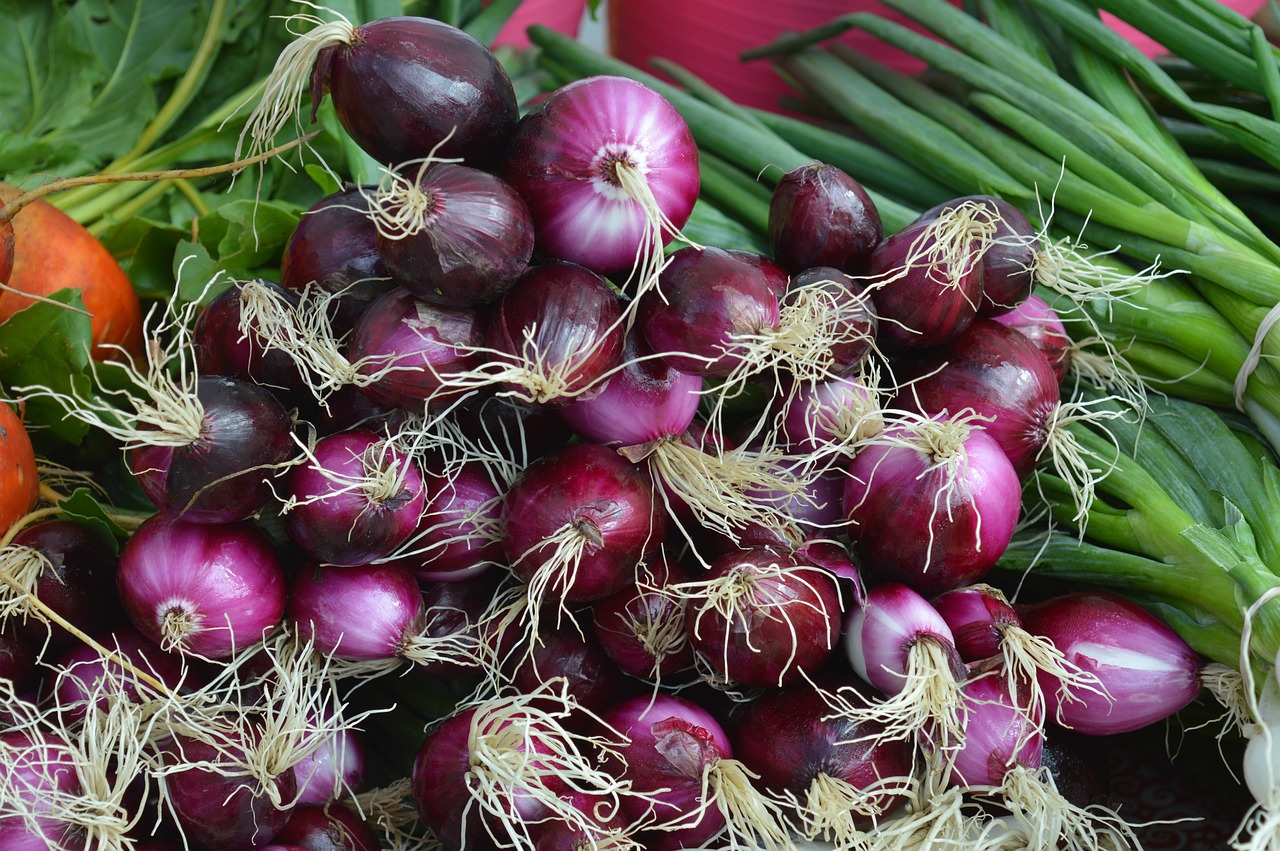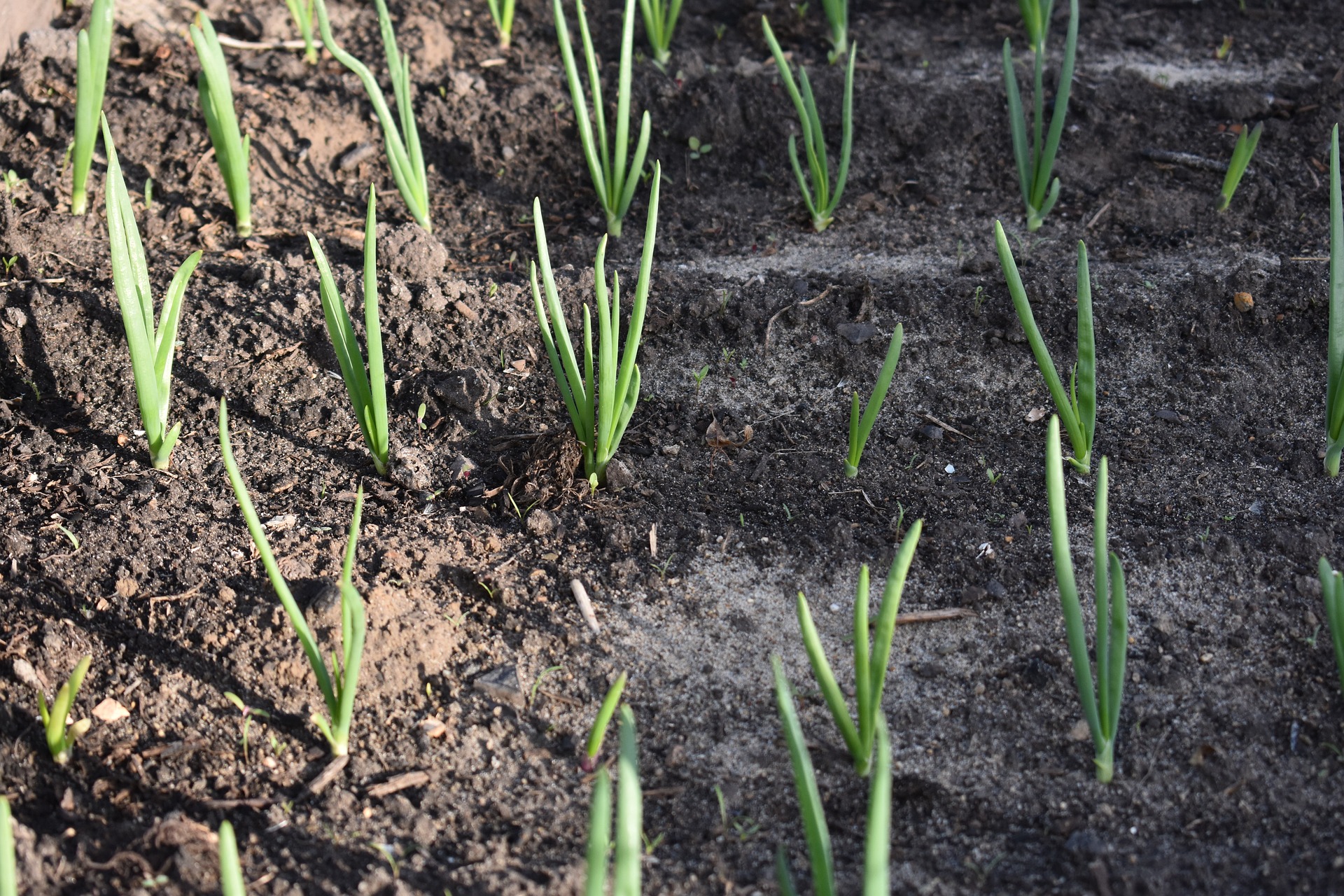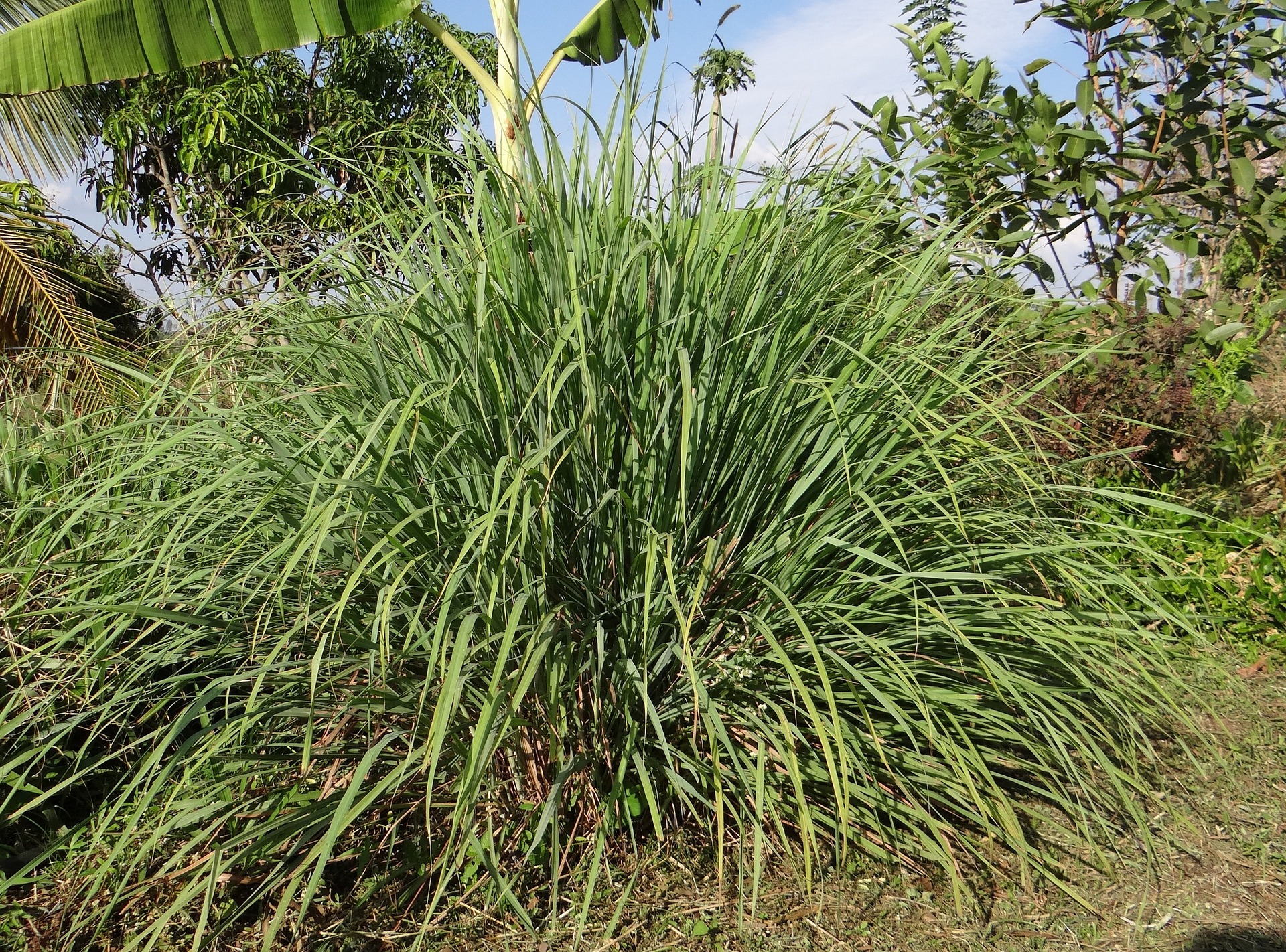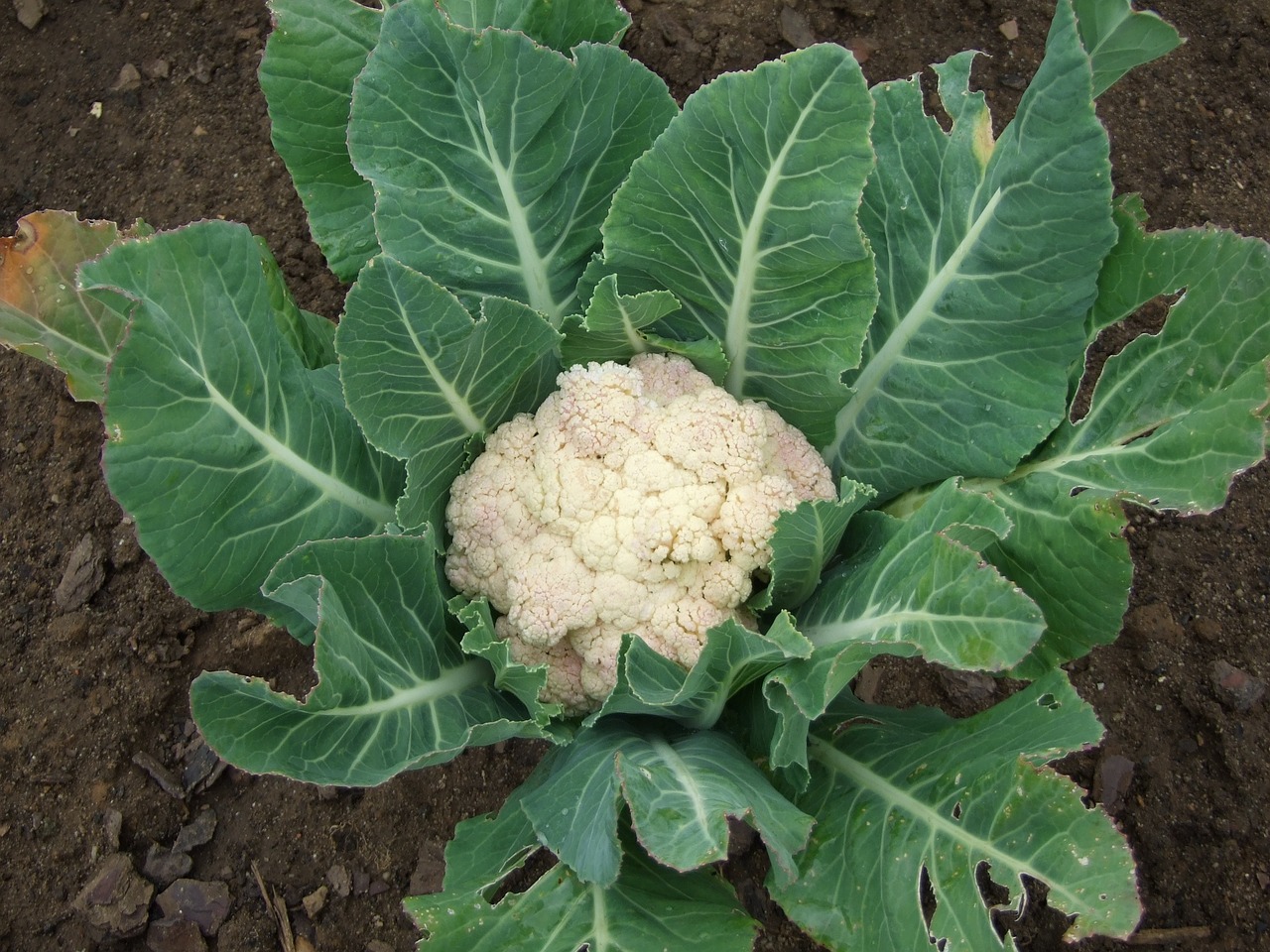The flavor and aroma of onions are integral to many culinary dishes, providing depth, complexity, and a signature taste that enhances a wide range of cuisines worldwide. Whether raw, caramelized, sautéed, or roasted, onions contribute essential flavor and aroma components that elevate the dishes they are used in.
In a garden, the long, slender leaves of onion plants emerge from the ground and create a lush, green foliage canopy, adding a touch of elegance to the garden, especially when planted in rows or clusters.
Onions are also nutritious with a variety of vitamins, minerals and phytochemicals, making them a valuable addition to a home garden.
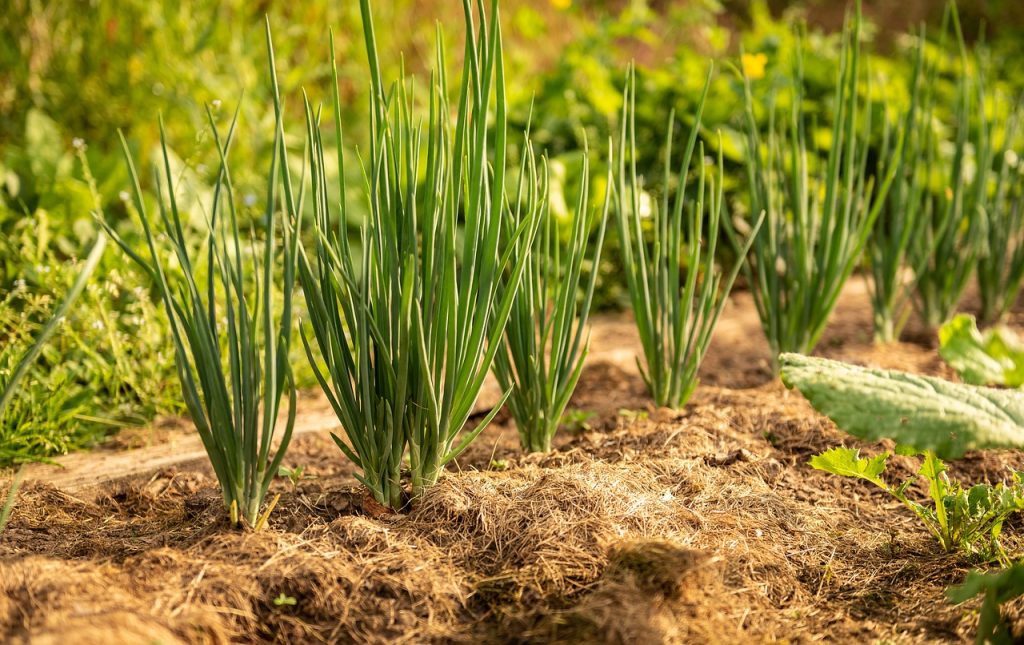
Description
Onions, (Allium cepa), are herbaceous biennial plants belonging to the family Amaryllidaceae and genus Allium, which also includes garlic, leeks and shallots.
They are one of the most widely consumed vegetables in the world and are mainly grown for their edible bulb. Onion bulbs have a layered structure and a papery outer skin that encases multiple layers of fleshy, concentric rings.
Onions have a pungent and savory flavor when raw, which becomes milder and sweeter when cooked. This flavor profile makes them a fundamental ingredient in many cuisines worldwide. They are low in calories and fat but rich in essential nutrients such as vitamin C, vitamin B6, potassium, and dietary fiber. They also contain antioxidants and various phytochemicals that contribute to numerous health benefits.
| Botanical name: Allium cepa | Propagation: Seeds, scraps |
| Common name: Onion | Soil type: Loamy |
| Family: Amaryllidaceae | Soil pH: 6.0-7.5 |
| Plant type: Biennial | Temperature: 60°F to 75°F |
| Hardiness zones: USDA zones 4-19 | Light: Full sun |
| Mature size: 12–18 in. tall, 6–12 in. wide | Spacing: 4-6in. |
| Flower color: White, purple | Pollination: Insects |
| Time to maturity: 100-120 days | Toxicity: Toxic to dogs, cats and horses |
| Native area: Southwestern Asia |
Types of Onions
Yellow Onions: These are the most common type with a strong, pungent flavor. They are versatile and used in a wide range of dishes.
Red Onions: Known for their vibrant color and milder flavor, red onions are often used raw in salads and sandwiches.
White Onions: White onions have a milder taste compared to yellow onions and are commonly used in Mexican and other cuisines.
Sweet Onions: Varieties like Vidalia and Walla Walla are known for their sweetness and are great for eating raw or lightly cooked.
Green Onions (Scallions): These have long, green stalks and a mild flavor. They are often used as a garnish.
Temperature requirements
Onions grow best in cooler temperatures. The optimal temperature range for onion growth is between 60°F to 75°F (15°C to 24°C). They can tolerate higher temperatures, but prolonged exposure to temperatures above 80°F (27°C) may result in reduced bulb formation.
Soil requirements
Onions prefer soil that is well-drained, allowing excess water to drain away easily. Waterlogged soil can cause bulbs to rot and inhibit root growth.
Grow onions in loamy soil with pH of 6.0-7.5 for optimal growth.
Onions are heavy feeders and require soil that is rich in organic matter. Amend the soil by adding organic matter in form of rotten animal manure or compost before planting.
Light/Sun requirements
Onions require full sun for optimal growth. Choose a location with at least 6-8 hours of sunlight per day.
Garden preparation
Perform a soil test to determine soil pH and nutrient levels. Onions prefer slightly acidic to neutral soil with a pH of 6.0 to 7.5.
Based on the soil test results, add lime to the soil if pH is too acidic. Add organic matter such as compost, well-rotted manure, or peat moss to improve soil structure, fertility, and drainage.
Use a garden fork or tiller to loosen the soil to a depth of at least 6-8 inches. This helps improve aeration and root penetration.
Planting Onions
Select onion varieties that are well-suited to your growing region and preferred bulb size. There are short-day, long-day, and intermediate-day varieties, each suited to different latitudes and day lengths.
Onions can be planted from sets, transplants or seeds.
From Sets: Onion sets are small bulbs that are typically planted in the early spring. Choose sets that are firm and free from mold or disease. Plant sets with the tip just at or slightly below the soil surface, spaced 4-6 inches apart in rows spaced 12-18 inches apart.
From Transplants: Transplants are young onion plants started from seeds and grown in containers or trays. Plant transplants at the same depth they were growing in their containers, spaced 4-6 inches apart in rows spaced 12-18 inches apart.
From Seeds: Onion seeds can be sown directly in the garden or started indoors 6-8 weeks before the last frost date. Sow seeds thinly in rows with a spacing of 12-18 inches, at a depth of about ¼ to ½ inch. Thin seedlings to the desired spacing once they emerge.
How to Care for Onions
Watering: Provide consistent moisture to onions, especially during dry periods. Onions prefer regular, deep watering but the soil should not be waterlogged.
Fertilization: Fertilize onions with a balanced fertilizer at planting time. Side-dress with nitrogen fertilizer when the plants are about 6 inches tall and again when they begin to bulb.
Mulching: Apply a layer of organic mulch around the onions to conserve moisture, suppress weeds, and maintain even soil temperatures.
Weeding: Keep the onion bed free from weeds, as they can compete for nutrients and water.
Thinning: If you started onions from seeds, thin them when the seedlings are a few inches tall to ensure proper spacing.
Harvesting Onions
Onions are typically ready for harvest when the tops turn yellow and start to fall over This usually occurs 100-120 days after sowing from seeds, depending on variety. . Harvesting is often done in the summer or early fall, depending on the planting time and variety.
Using a garden fork or trowel, carefully loosen the soil around the onions. Be cautious not to damage the bulbs while doing this.
Once the soil is loosened, carefully lift the onions from the ground. You can grab them by the tops and gently pull them up, or use a garden fork to lift them out of the soil.
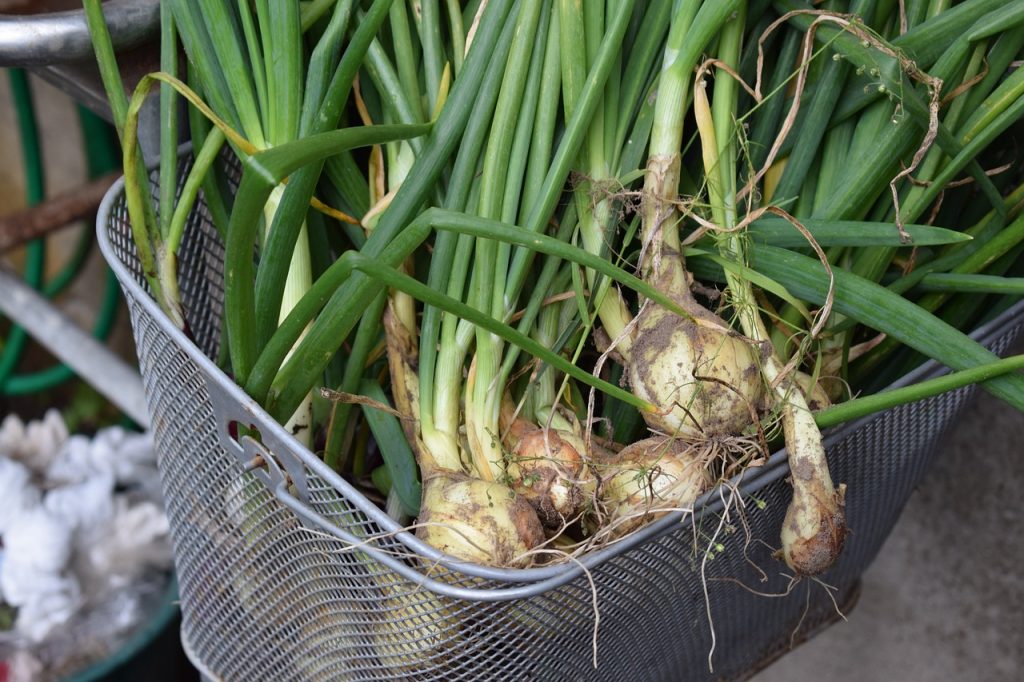
Curing and Storage
After harvesting, move onions to a dry, well-ventilated area like a shed or garage. Lay them out in a single layer, allowing them to dry for a few days to a week. This process is called curing and helps to toughen the skin, which improves their storage life.
Once the onions are dry, trim the tops down to about an inch above the bulb. This helps prevent rot during storage.
After curing and trimming, store onions in a cool, dry place with good air circulation. Braiding or hanging them in mesh bags are common methods of storage. Alternatively, you can store them in crates or baskets, making sure they’re not overcrowded to allow air to circulate around them.

Common pests and diseases
Pests include:
Thrips: These are tiny insects that suck sap from onion leaves, causing silvering or stippling.
Control: Introduce beneficial insects like predatory mites, apply insecticidal soap for control.
Onion Maggots: Larvae feed on onion roots, leading to wilting and stunted growth.
Control: Practice crop rotation, use row covers to prevent adult flies from laying eggs and apply insecticidal soil drenches if an infestation occurs.
Onion Fly: Larvae burrow into onion bulbs, causing damage.
Control: Use row covers to protect plants, practice crop rotation and apply insecticides in case of an infestation.
Diseases include:
Downy Mildew: Yellow or pale green lesions on leaves, followed by a downy white growth on the underside.
Control: Provide good air circulation by spacing plants adequately, avoid overhead watering and apply fungicides containing copper in case plants get infected.
White Rot: White, fluffy fungus on bulbs, leading to decay and a foul odor.
Control: Rotate crops to prevent buildup of pathogens in the soil, plant in well-drained soil and destroy infected plant material.
Purple Blotch: Purple-black lesions on leaves that may spread to bulbs.
Control: Provide adequate spacing for good air circulation, use disease-resistant onion varieties and apply appropriate fungicides as indicated on the package label in case of an infestation.
Top of Form

